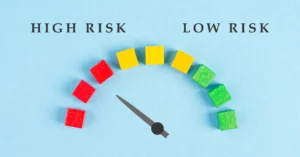Low leverage vs. high leverage is a debate that every forex trader encounters, especially when markets become unpredictable and volatility spikes. Making the right choice between low leverage and high leverage is much more than a question of how quickly you can grow your account; it’s about how effectively you can manage risk and avoid catastrophic losses when prices start swinging. In today’s fast-moving trading environment, knowing whether to choose low leverage vs. high leverage could be the difference between long-term survival and a wiped-out account.
Let’s explore how both approaches work in real-world forex trading and which is truly safer in volatile markets.
What is leverage, and why does it matter?
First, let’s clear up what leverage really means in forex. Leverage is the ability to control a much larger position size than the cash you have in your trading account. Your broker provides the borrowed funds, while you put up a fraction (your margin). It’s what makes forex accessible for so many people—you don’t need $100,000 to trade $100,000 worth of currency.
But leverage cuts both ways. With 1:100 leverage, a $500 deposit controls a $50,000 position. If your trade goes well, you can make big returns even on tiny moves. But if the trade goes against you, losses are just as amplified. One or two wrong moves, and your account could be wiped out before you can react.
Why Volatility Exposes the Truth About Leverage
Now, let’s get real about volatility. There are days or even weeks in the market when prices drift in tight ranges. On those days, high leverage can look tempting. But the real test comes when news breaks, data surprises hit, or central banks announce unexpected decisions. Suddenly, prices jump or dive in seconds.
That’s when the choice between low leverage vs. high leverage has consequences. A single pip can mean a small loss with low leverage or a devastating margin call with high leverage. During volatile markets, even experienced traders can get caught off guard. A classic example is the infamous “flash crash” in the pound or the massive move in the Swiss franc in 2015. High-leverage traders were wiped out in minutes—some even ended up owing money to their brokers.
Margin Trading Strategies for Different Types of Traders
Different traders, different strategies. A new trader might be drawn to the idea of turning $100 into $1,000 with one lucky move. But the more experienced you get, the more you realise that trading is about protecting your account—not just making it bigger.
Many professional traders, hedge funds, and institutions use leverage, but rarely at the highest level. Instead, they prioritise risk management. They know that low leverage gives them a margin for error—something every trader needs, especially in volatile conditions.
A common rule among experienced traders: never risk more than 1–2% of your trading account on a single position. That means sizing trades carefully and using leverage that matches the risk—not just chasing the biggest possible profits. Over time, these habits are what separate survivors from casualties.
Forex Risk Management: Why Survival Trumps Speed
Let’s dig deeper into risk management, the backbone of every successful trading approach. It’s not about how much you can make, but how much you can lose and still come back. The traders who last the longest are those who see every day as a marathon, not a sprint.
For example, you have a $2,000 trading account. If you use 1:10 leverage, your maximum position size is $20,000. If you risk 2% of your account ($40) on a trade, you’re protected from any single trade ruining your account. Now, if you take the same $2,000 and use 1:100 leverage, you can open a $200,000 position—huge potential, but if the market moves 1% against you, that’s a $2,000 loss. One trade, and you’re done.
Low leverage isn’t about playing it safe for the sake of it—it’s about staying in the game. Markets don’t care about your dreams of doubling your account overnight. They reward patience, discipline, and good risk habits.
Leverage Impact on Trading Results
Nothing drives the lesson home like numbers. Let’s run two scenarios.
Scenario 1:
Trader A uses 1:100 leverage on a $1,000 account. She opens a position worth $100,000. A 1% move against her costs $1,000—her whole account.
Scenario 2:
Trader B uses 1:10 leverage with the same $1,000. He opens a $10,000 position. The same 1% move against him costs $100—a loss, but he still has $900 left and can keep trading.
Multiply these moves by the number of trades made in a volatile market, and you see why so many accounts get wiped out with high leverage. The impact is instant, and there’s little room for error or recovery. With low leverage, the impact is less severe, emotions are steadier, and traders can adjust, learn, and keep going.
How Emotions and Leverage Mix in Volatile Markets
Trading is never just about numbers. It’s about people, their fears, their hopes, and their reactions when things go sideways. High leverage doesn’t just amplify profits and losses; it also amplifies emotions.
When you’re trading with high leverage, every small price movement feels huge. A small win is exhilarating, but a small loss feels like disaster. This emotional rollercoaster can lead to revenge trading, impulsive decisions, and bigger losses. In contrast, low leverage makes the ups and downs manageable. You can follow your plan, make rational decisions, and stick with your strategy even when the market is jumping.
True Stories: Lessons from Real Traders
Ask any experienced trader, and you’ll hear the same story. Most of them blew up their first or second account because they used too much leverage, especially during wild market swings.
Take the 2015 Swiss franc shock. When the Swiss National Bank suddenly removed its peg to the euro, the franc soared by over 20% in minutes. High-leverage traders, even those with stop-losses, lost everything. Some owed their brokers more than their deposits. Low-leverage traders took losses, too, but most survived to trade another day. That’s the difference between staying power and a single bad trade ending your journey.
Or talk to anyone who traded through Brexit, COVID-19 market shocks, or any major central bank announcement. The common thread is clear: those who kept their leverage low could withstand the storm, learn, and get better.
How to Use Leverage Wisely: Tips for Every Trader
So, what should you actually do in practice? Here are some habits and ideas that come straight from the desks of long-term traders:
- Always use a stop-loss, and never widen it in hope. Discipline saves accounts.
- Keep your position sizes small enough that you can lose several trades in a row and still keep trading.
- When volatility spikes, lower your leverage. Sometimes, the best trade is no trade.
- If you’re ever in doubt, trade even smaller or just watch the market. Learning can happen outside of live trades.
- Review every trade, win or lose. Ask yourself what you did right and what you could improve.
- Remember: the market will always be there. Your capital is precious—protect it above all.
Brokers, Regulation, and Leverage: What to Watch Out For
Brokers are in business to make money, and some will offer extremely high leverage to attract new traders. But the best brokers care about your longevity as a trader. Look for brokers regulated in major financial centres, where leverage limits are set to protect you.
Read the terms for margin calls and stop-outs before opening an account. Choose brokers that offer educational tools, risk calculators, and demo accounts. The right partner can make a world of difference in your trading journey.
Adapting Your Approach: No Market Is Ever the Same
One of the most underrated skills in trading is flexibility. What works in a trending, calm market might fall apart during a news-driven frenzy. The most successful traders constantly reassess their risk, their leverage, and their position sizes based on the market environment.
When volatility is low, you might cautiously use a bit more leverage—always within your comfort zone and with tight stops. But when the market is volatile, it pays to shrink your positions and ride out the storm with minimal exposure.
The Bottom Line: Why Low Leverage Almost Always Wins
Trading is all about longevity. The truth is, very few people get rich from one trade. Most success comes from hundreds, even thousands, of disciplined trades over months and years. Low leverage supports this approach—it allows you to survive bad days, learn from mistakes, and stay in the game long enough for your edge to work.
High leverage is a siren song for new traders, but the market is full of stories where it ended badly. Focus on forex risk management first, and let your account size and leverage match your experience and risk tolerance. The more you value your capital, the better your results will be.
Key Takeaways: Real-World Survival for Traders
- Leverage lets you control more with less, but it multiplies risk just as much as reward.
- Volatile markets expose the weaknesses of high leverage quickly and ruthlessly.
- Low leverage gives you time to recover, learn, and keep trading, even after losses.
- Good margin trading strategies always start with risk management, not profit chasing.
- The leverage impact on trading results is often most obvious after big market moves when it’s too late to adjust.
- If you want to be here next year (and the year after that), choose survival and discipline over speed.
Final Thoughts: The Choice Is Yours
Every trader has to face the low leverage vs. high leverage question. There’s no one-size-fits-all answer, but the lessons from both the winners and the losers are clear. In volatile markets, those who play it safe with low leverage almost always come out ahead, not just in profits, but in experience and longevity.
Trading isn’t about making money fast. It’s about not losing money fast. The sooner you embrace the power of risk management and the safety of low leverage, the better your chances of building real, lasting trading success.
So next time the market goes wild, ask yourself: do I want excitement, or do I want to last? For most traders, the answer is clear: choose the path that keeps you trading tomorrow and every day after that.
Read here to learn more about “Leverage in Forex: Must-Know Strategies for Today’s Trading“.

I’m Chaitali Sethi — a seasoned financial writer and strategist specializing in Forex trading, market behavior, and trader psychology. With a deep understanding of global markets and economic trends, I simplify complex financial concepts into clear, actionable insights that empower traders at every level. Whether it’s dissecting winning strategies, breaking down market sentiment, or helping traders build the right mindset, my content bridges the gap between information and implementation.




